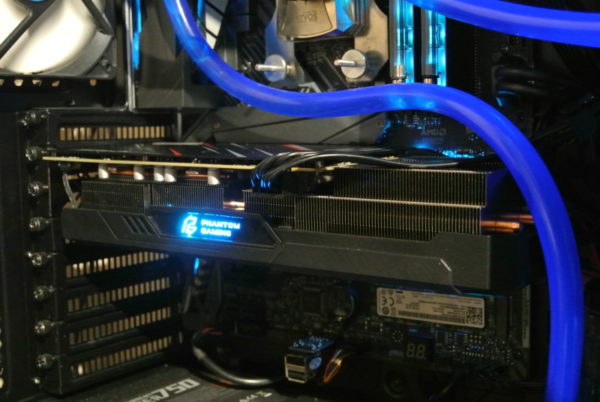
Setup and test results …
Our test system looks like this:
AMD Ryzen 7 3700X
2x 8GB ADATA DDR4-3600
ASRock Fatal1ty X470 Gaming K4
Samsung M2 SSD 256GB
Phanteks Enthoo Pro M enclosure
Sharkoon WPM700 700Watt power supply
Custom water cooling
The operating system used was Windows 10 Pro 64-bit (1909 Build 18363.752).
In order to make the benchmark course a bit more extensive, we have decided to use the following benchmarks:
Unigine Heaven Extreme
Unigine Superposition 1080 Medium
Unigine Superposition 1080 Extreme
3DMark Firestrike
3DMark Firestrike Extreme
3DMark TimeSpy
3DMark TimeSpy Extreme
We performed the load tests with Unigine Heaven and the somewhat unrealistic Furmark. The graphics cards’ power consumption was determined using AMD Radeon software. All tests took place in a closed case.
Let’s now test the ASRock RX 5600 XT Phantom Gaming. This is roughly in line with nVidia’s RTX 2060 or GTX 1080 in terms of performance. The rates are solid due to the bench, but at least our sample shows that the RX 5600XT out of the box isn’t an overclocking miracle. We were able to increase the GPU clock by 10%, limited by the driver, but we could only get 1% more performance out of it. Without a stronger voltage increase and the resulting cooling it seems to be over relatively early.
| ASRock Radeon RX 5600 XT Phantom Gaming benchmark results | |||||||||
| Mode | GPU MHz | RAM MHz | Unigine Heaven Extreme | Unigine Superposition 1080 Medium | Unigine Superposition 1080 Extreme | 3DMark Firestrike | 3DMark Firestrike Extreme | 3DMark Timespy | 3DMark Timespy Extreme |
| Default Mode | 1530/1670/1750 | 1500 | 2589 | 13595 | 3931 | 18448 | 9497 | 7410 | 3286 |
| OC Mode | 1530/1670/1820 | 1500 | 2605 | 13745 | 3989 | 18691 | 9544 | 7451 | 3303 |
The power consumption and temperatures are no different from the increase in performance. The card already clocks close to the limit thanks to ASRock’s custom clock rates. You can’t get much more here either.
| ASRock Radeon RX 5600 XT Phantom Gaming Temperature and power consumption | ||||||||
| Mode | load test | GPU MHz | RAM MHz | temperature | power consumption | voltage GPU | fan | subjective volume |
| Default Mode | Unigine Heaven | 1530/1670/1750 | 1500 | 62°C | 115W | 950mV | 1100rpm | silent |
| Default Mode | Furmark | 1530/1670/1750 | 1500 | 71°C | 130W | 981mV | 2069rpm | audible |
| OC Mode | Furmark | 1530/1670/1820 | 1750 | 73°C | 133W | 962mV | 2061rpm | audible |
Away from the synthetic benchmarks, we tested the ASRock Radeon RX 5600 XT Phantom Gaming D3 6G OC in comparison to the ASRock Radeon RX 5500 XT Phantom Gaming D 8G OC in various games like GTA V, Final Fantasy XV and Battlefield 5. Both cards delivered a first-class gaming experience in their respective performance classes. Of course we also ventured into VR titles. In The Walking Dead Saints & Sinners both cards cut a good figure, although with the RX 5500XT one had to make compromises in quality in favour of the FPS. The additional 2 GB memory unfortunately doesn’t help there.
The RX 5600XT Phantom Gaming on the other hand performs much better through the bench and if you’re afraid that the 6 GB V-RAM could become a bottleneck, we can reassure you. This should not be the case. The RX 5500XT does have 8GB V-Ram, but can rarely or never take advantage of it, as the frame rates previously collapse to an underground level. Both graphics cards are perfectly suited for FullHD gaming, although we were able to set the details to high to very high with the RX 5600XT in some games at WQHD resolution!
ASRock Radeon RX 5600 XT Phantom Gaming D3 6G OC Grafikkarten Result and general impression …


